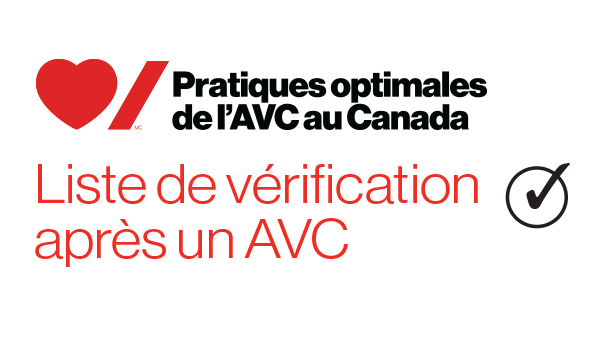- Définitions
- Éléments fondamentaux des services de prévention de l’AVC
- 1. Triage et évaluation diagnostique initiale de l’accident ischémique transitoire (AIT) et de l’AVC non invalidant
- 2. Prise en charge du mode de vie et des facteurs de risque
- 3. Pression artérielle et prévention de l’AVC
- 4. Prise en charge des lipides
- 5. Prise en charge du diabète et de l’AVC
- 6. Traitement antiplaquettaire des cas d’AVC ischémique et d’AIT
- 7. Traitement anticoagulant visant la fibrillation auriculaire
- 8. Prise en charge périopératoire du traitement anticoagulant et du traitement antiplaquettaire
- 9. Prise en charge de la maladie artérielle carotidienne extracrânienne et de l’athérosclérose intracrânienne
- 10. Problèmes cardiaques concomitants chez les personnes ayant subi un AVC
- 11. AVC ischémique associé au cancer
Recommandations
Remarque : Pour une prise en charge détaillée de la dyslipidémie, consultez les lignes directrices les plus récentes de la Société canadienne de cardiologie à ce sujet : https://ccs.ca/fr/a-propos-des-lignes-directrices/.
4.0 Lipides
4.0 Les taux sériques des lipides des personnes victimes d’un AVC ischémique ou d’un AIT devraient être évalués et pris en charge de manière optimale [niveau de preuve A].
4.1 Évaluation des lipides
- Les taux sériques des lipides, y compris le cholestérol total, les triglycérides, le cholestérol LDL [lipoprotéines de faible densité] et le cholestérol HDL [lipoprotéines de haute densité], devraient être mesurés chez les patients ayant subi un AVC ischémique ou un AIT [niveau de preuve B].
Voir le tableau 1A pour en savoir plus sur les analyses de laboratoire.
4.2 Prise en charge des lipides
-
La prise en charge des lipides visant une baisse des taux chez les personnes victimes d’AVC ischémique ou d’AIT devrait s’accompagner d’une modification importante du mode de vie, y compris de l’alimentation et du niveau d’activité physique, dans le cadre d’une approche globale qui vise à diminuer le risque de récidive d’AVC ou d’autres problèmes vasculaires, sauf en cas de contre-indication [niveau de preuve B]. Voir les recommandations de prise en charge du mode de vie dans la section 2 du chapitre sur la prévention secondaire de l’AVC.
-
Une pharmacothérapie à base de statines devrait être prescrite en vue de la prévention secondaire des AVC aux personnes qui ont été victimes d’un AVC ischémique non cardioembolique ou d’un AIT [niveau de preuve A]. Voir les lignes directrices les plus récentes sur la dyslipidémie de la Société canadienne de cardiologie pour obtenir de plus amples renseignements sur la prise en charge des lipides.
-
Il est recommandé d’avoir comme cible un taux de cholestérol LDL inférieur à 1,8 mmol/L [niveau de preuve B].
-
-
Il ne faut pas entreprendre un traitement aux statines pour la prévention secondaire d’une hémorragie intracérébrale [niveau de preuve C]. Voir le chapitre sur la prise en charge de l’hémorragie intracérébrale des Recommandations pour en savoir plus sur les stratégies de prévention des AVC dans cette population.
-
Traitements en association pour réduire le taux de LDL (NOUVEAU EN 2020) :
-
Dans le cas des personnes ayant subi un AVC ischémique et souffrant d’une maladie cardiovasculaire athérosclérotique, et dont le taux de LDL est supérieur à 1,8 mmol/L malgré un traitement aux statines selon la dose maximale tolérée, l’ézétimibe peut être envisagé pour une réduction supplémentaire du taux de LDL [niveau de preuve B].
-
Dans le cas des personnes atteintes d’une maladie cardiovasculaire athérosclérotique concomitante pour laquelle le niveau cible de cholestérol LDL n’est pas atteignable, on peut envisager de les aiguiller vers un professionnel de la santé spécialisé dans la prise en charge du métabolisme et des lipides ou dans les AVC pour l’ajout possible d’un inhibiteur de PCSK9 [niveau de preuve A].
-
-
Traitements en association pour l'hypertriglycéridémie (NOUVEAU EN 2020)
Chez les patients ayant subi un AVC ischémique présentant une maladie cardiovasculaire athérosclérotique établie ou un diabète accompagné de facteurs de risque vasculaire supplémentaires qui ont des taux de triglycérides sériques élevés (≥1,5 mmol/L) malgré un traitement aux statines, on peut envisager l’icosapent éthyle à 2 g, deux fois par jour, pour diminuer le risque d’événements vasculaires [niveau de preuve B].
4.3 Intolérance aux statines (nouveau 2020)
- Chez les patients présentant une intolérance aux statines (y compris des myalgies persistantes, des anomalies importantes et persistantes des enzymes hépatiques ou, plus rarement, une myopathie ou une rhabdomyolyse), il faut confirmer l’indication d’un traitement aux statines et, en général, il faut envisager une évaluation systématique de la contribution des statines aux symptômes du patient (y compris l’arrêt temporaire des statines avec observation des symptômes, un ajustement de la dose, l’utilisation d’autres agents) [niveau de preuve C].
Remarque : Pour la prise en charge de la dyslipidémie en prévention primaire d’épisodes cardiovasculaires, y compris l’AVC, voir les plus récentes lignes directrices pour le diagnostic et le traitement de la dyslipidémie de la Société canadienne de cardiologie.
Les taux élevés de cholestérol et de lipides dans le sang sont associés à un risque accru d’AVC et d’infarctus du myocarde. Les médicaments hypocholestérolémiants de la catégorie des statines ont des effets bénéfiques chez les personnes qui ont déjà été victimes d’un AVC ischémique ou d’un AIT. Une baisse marquée du cholestérol LDL est susceptible de donner de meilleurs résultats qu’une baisse plus modérée. Une diminution de 16 à 30 % du risque relatif de récidive d’épisodes vasculaires a été démontrée récemment chez des patients avec des antécédents d’AVC sans maladie coronarienne traités au moyen de statines.
La Cholesterol Treatment Trialists, une méta-analyse de 14 essais cliniques de statines, révèle que la baisse du cholestérol LDL entraîne une réduction relative du risque de maladies cardiovasculaires qui est proportionnelle à la dose. Chaque diminution de 1,0 mmol/L du cholestérol LDL est associée à une réduction correspondante de 20 à 25 % de la mortalité cardiovasculaire et de l’incidence d’infarctus du myocarde non fatal avec un NST de 30 selon l’essai Treat to Target (2020).
Les personnes qui ont subi un AVC font état d’un grand nombre d’approches différentes de prise en charge des lipides; certaines sont aiguillées vers un spécialiste des lipides et d’autres sont suivies par leur médecin de famille, tandis que d’autres ont déclaré n’avoir jamais eu de discussion sur les lipides (Prévention secondaire de l’AVC, comité de consultation et d’évaluation communautaire, 2019). Une approche personnalisée de la prise en charge des lipides est nécessaire pour aider les gens à atteindre leurs cibles lipidiques appropriées. Notre comité d’évaluation communautaire souligne l’importance d’une approche globale de la prise en charge des lipides qui comprend l’éducation sur les médicaments, le régime alimentaire, l’activité physique, la gestion du poids et des renseignements clairs sur le bilan lipidique cible, le traitement pharmacologique prescrit, les effets secondaires potentiels et la manière de les prendre en charge.
Remarque : Les essais cliniques les plus récents ne comprennent pas suffisamment de patients ayant subi un AVC qui sont atteints de fibrillation auriculaire ou d’autres troubles cardioemboliques pour nous permettre de formuler des recommandations pour cette population de patients. La décision d’utiliser des statines dans ces cas devrait être fondée sur le risque cardiovasculaire global auquel le patient est exposé. Nous ne savons pas encore si les statines ont des effets bénéfiques chez les patients ayant subi un AVC et souffrant par ailleurs de fibrillation auriculaire.
- Programmes concertés, aux échelons provinciaux et communautaires, visant la sensibilisation à la dyslipidémie, auxquels participent les groupes communautaires, les dispensateurs de soins primaires (y compris les médecins, les infirmières praticiennes et les pharmaciens) et les autres partenaires pertinents.
- Mesures de prévention de l’AVC, notamment la surveillance du bilan lipidique et l’éducation, mises de l’avant par les dispensateurs de soins primaires en milieu communautaire
dans le cadre de la prise en charge globale du patient. - Disponibilité et facilité d’accès accrues à des programmes de formation sur le diagnostic et la prise en charge de la dyslipidémie pour les fournisseurs de soins à toutes les étapes du continuum de soins
- Harmonisation en fonction des recommandations et lignes directrices du groupe de la dyslipidémie de la Société canadienne de cardiologie.
- Accès universel et équitable à des médicaments efficaces et peu coûteux pour tous les habitants du pays, sans égard à la géographie, à l’âge ou à la capacité de payer.
- Proportion des patients ayant subi un AVC dont les taux de lipides ont été établis dans le cadre de l’évaluation exhaustive initiale.
- Proportion de la population déclarant avoir des taux de lipides élevés, en particulier de cholestérol LDL.
- Proportion des patients ayant eu un AVC auxquels on a prescrit des agents hypolipidémiants en prévention secondaire de l’AVC au moment de leur congé des soins aigus, par l’intermédiaire d’une consultation de prévention secondaire ou par un fournisseur de soins primaires (y compris les médecins et les infirmières praticiennes).
Notes sur la mesure des indicateurs
- Indicateurs de rendement 1 et 2 : Données pouvant provenir de l’Enquête sur la santé dans les collectivités canadiennes.
- Indicateur de rendement 2 : Les valeurs sériques doivent être tirées, dans la mesure du possible, des rapports officiels des laboratoires.
- Indicateur de rendement 3 : Les sources de données peuvent comprendre les ordonnances des médecins, les notes des médecins et du personnel infirmier, les résumés produits au moment du congé ou les copies des ordonnances données aux patients
- Les ordonnances d’agents hypolipidémiants peuvent être rédigées durant le séjour à l’hôpital, en clinique de prévention secondaire ou dans le cadre de soins primaires. Il est par conséquent important de noter le contexte de soins dans lequel la thérapie a été amorcée.
- Une ordonnance donnée à un patient ne veut pas dire qu’elle est observée.
Health Care Provider Information
- Cœur + AVC – Liste de vérification après un AVC
- Recommandations canadiennes pour les pratiques optimales de soins de l’AVC – Prise en charge de l’hémorragie intracérébrale spontanée, prévention secondaire de l’AVC chez les personnes ayant subi une hémorragie intracérébrale
- Recommandations de la Société canadienne de cardiologie sur la dyslipidémie
- Outil de calcul du risque cardiovasculaire de Framingham (anglais uniquement)
- Matériel pédagogique destiné aux patients de la National Heart, Lung and Blood Institute (anglais uniquement)
Renseignements destinés aux personnes ayant subi un AVC, à leurs familles et à leurs aidants
Lipid Management Evidence Tables and Reference List
Given the well-documented causal relationship between dyslipidemia and the development of atherosclerosis, appropriate management is important for both primary and secondary prevention of stroke. To maximize treatment and improve outcomes for cardiovascular disease, current strategies emphasize the need to balance lifestyle and risk factor modifications through behaviors change with pharmacological intervention.
Evidence from several systematic reviews has demonstrated a significant reduction in overall risk of ischemic stroke and other vascular events associated with lipid-lowering therapies. In one of the more recent Cholesterol Treatment Trialists (CTT) publications (Fulcher et al. 2015), 27 RCTS (n=186,854) were included, in which the treatment aim was solely the reduction of LDL cholesterol and was continued for at least two years. Treatment contrasts included statin vs. placebo and more intensive vs. less intensive treatment. After a median duration of follow-up of 4.9 years, overall, statins reduced the risk of a major vascular event by 21% per each 1.0 mmol/L reduction in LDL-chol (RR=0.79, 95% CI 0.77-0.81), with no significant interaction reported for sex. The risks of any stroke and any vascular death were also decreased significantly with statin therapy (RR=0.85, 95% CI 0.80-0.89, and RR=0·88, 95% CI 0·84−0·91, respectively), again with no significant interaction based on sex. Statins significantly reduced the risk of a major vascular event and vascular death across all age groups from ages ≤55 to >75 years, per each 1.0 mmol reduction in LDL-chol (Armitage et al. 2019). Lipid-lowering treatment was associated with a significant decrease in stroke risk among persons with a >5% to 30%, 5-year risk of stroke (Mihaylova et al. 2012).
The results of many primary prevention trials including participants with cerebrovascular risk factors have demonstrated the effectiveness of statin therapy. Although too many to describe in detail, we present the results of just a few that compared varying doses of statins with placebo, which included persons with differing levels of cardiovascular risk. The Heart Protection Study (2002) randomized 20,536 patients with coronary artery disease, cerebrovascular disease, peripheral vascular disease, diabetes or patients over 65 years with hypertension and a total serum cholesterol of > 3.4 mmol/L to receive 40 mg simvastatin or placebo for a mean duration of five years. There was a significant reduction in ischemic stroke associated with statin therapy (RRR=25%, 95% CI 15%– 44). In addition, patients in the simvastatin arm required fewer carotid endarterectomies and angioplasties. These benefits were evident across all subgroup, even those whose baseline LDL cholesterol was under 2.6 mmol/L, suggesting the decision to initiate statin therapy should include an assessment of a patient’s absolute risk of cardiovascular disease, rather than just their LDL cholesterol concentration. A statin dose of 20 mg/day was used in the Justification for the Use of Statins in Prevention Trial Evaluating Rosuvastatin (JUPITER) trial (Ridker et al. 2008). This trial, which was terminated early (median of 1.9 years), included 17,802 men (≥50 years) and women (≥60 years) without a history of cardiovascular disease, with a normal LDL-chol level, but with elevated C-reactive protein levels of ≥2.0mg/L. Study participants were randomized to receive 20 mg/day rosuvastatin or placebo. There were significantly more strokes (any and nonfatal) (64 vs. 33 and 58 vs. 30, respectively). The associated hazard ratios were 0.52, 95% CI 0.34-0.79, p=0.002 and 0.52, 95% CI 0.33-0.80, p=0.003. Most recently, in the satin arm blood-pressure lowering arm of the Heart Outcomes Prevention Evaluation (HOPE)-3 trial, (Yusuf et al. 2016), patients at intermediate risk of cardiovascular disease (i.e., those without a history of CVD but with at least one or two risk factors, depending on age) were randomized to treatment with 10 mg/day rosuvastatin or placebo. At the end of follow-up (median of 5.6 years), the mean LDL-chol and apoprotein B-100 were significantly lower in the statin group by 26.5% and 22.0%, respectively. The risk of the first primary outcome, which included nonfatal stroke was significantly lower in the statin group (3.7% vs. 4.8%, HR=0.76, 95% CI 0.64-0.91, p=0.02). The risk of any stroke was also significantly lower in the statin group (1.1% vs. 1.6%, HR=0.70, 95% CI 0.52-0.95).
There has only been one large RCT evaluating statin monotherapy for secondary prevention of stroke (Amarenco et al. 2006). The Stroke Prevention by Aggressive Reduction in Cholesterol Levels trial (SPARCL) included 4,731 patients with previous stroke or transient ischemic attack within one to six months before study entry, who had LDL levels of 2.6 to 4.9 mmol/L and had no known coronary artery disease. Participants were randomized to receive treatment with atorvastatin 80 mg once daily or placebo. The mean LDL level during the trial was 1.9 mmol/L among patients receiving atorvastatin versus 3.3 mmol/L in the placebo group. The 5-year absolute reduction in risk of any stroke was 2.2 percent; with a relative risk reduction of 16%, and adjusted hazard ratio (HR) 0.84 (95% CI 0.71–0.99; p = 0.03). Based on this data, 46 patients would need to be treated for 5 years to prevent one stroke. The authors cautioned that the reduction in ischemic stroke (HR=0.78, 95% CI 0.66–0.94) should be weighed against the increased risk of hemorrhagic stroke (HR=1.66, 95% CI 1.08- 2.55). The five-year absolute reduction in risk of major cardiovascular events was 3.5 percent (HR=0.80, 95% CI 0.69–0.92; p = 0.002). More recently, the link between statin use and increased risk of intracerebral hemorrhage has been questioned. Using results from the VISTA archive, Scheitz et al. (2016), reported no increased risk of intracerebral hemorrhage following ischemic stroke in patients who were established previously on statin therapy or in those who were newly initiated on it.
When added to background statin therapy, the use of additional agents including, proprotein convertase subtilisin/kexin type 9 (PCSK9) inhibitor, a monoclonal antibody; ezetimbe, a cholesterol absorption inhibitor; and icosapent ethyl, a highly purified eicosapentaenoic acid ethyl ester, have been shown to be effective in further reducing vascular events in persons whose cholesterol and/or triglycerides, remain high on statin monotherapy, or in those who have had a further event. New recommendations have been made regarding the use of these agents in this update of the Canadian Stroke Best Practice Recommendations.
In persons with established atherosclerotic cardiovascular disease, the combination of 10 mg ezetimibe and 40 mg of simvastatin was found to be superior to monotherapy with simvastatin for reduction of the risk of vascular outcomes, including stroke (Cannon et al. 2015). The Improved Reduction of Outcomes: Vytorin Efficacy International Trial (IMPROVE-IT) included 18,144 patients recently hospitalized with acute coronary syndrome with elevated LDL cholesterol. The risk of the primary outcome (a composite of fatal and nonfatal cardiovascular events) over 7 years was significantly lower in the dual-therapy group (32.7% vs. 34.7%; HR=0.936, 95% CI 0.89-0.99, p=0.016). The risks of any stroke and ischemic stroke were significantly lower in the dual therapy group (HR=0.86, 95% CI 0.73-1.00, p=0.05 and HR=0.79, 95% CI 0.67-0.94, p=0.008, respectively), while the risk of hemorrhagic stroke was not reduced significantly. The use of ezetimibe to achieve further reductions in LDL cholesterol may help to protect against recurrent cardiovascular/cerebrovascular events. The Treat Stroke to Target trial (Amarenco et al. 2020) randomized 2,860 participants who had sustained an ischemic stroke in the previous 3 months or a transient ischemic attack within the previous 15 days, who had confirmed atherosclerotic disease, to receive treatment with either a statin or a statin + ezetimibe, if required, to achieve a target LDL cholesterol level of < 1.8 mmol/L, (lower-target group) or a target range of 2.3 to 2.8 mmol/L, (higher-target group), for the duration of the trial. At the end of follow-up (mean 3.5 years), the mean LDL cholesterol was 1.7 mmol/L in the lower-target group and 2.5 mmo/L in the higher-target group. The risk of major cardiovascular events, the primary outcome, was significantly lower in the lower-target group (8.5% vs. 10.9%, HR=0.78, 95% CI 0.61 to 0.98; p=0.04).
PCSK9 inhibitors have also been shown to reduce the risk of cardiovascular events, in addition to statin therapy. 19,924 persons with elevated LDL cholesterol and a hospitalization for an acute coronary syndrome who received 75 mg alirocumab subcutaneously every 2 weeks, in addition to maximum statin therapy, for an average of 2.8 years, had a 15% reduced risk of the primary outcome (a composite of death from coronary heart disease, nonfatal MI, fatal or nonfatal ischemic stroke, or unstable angina requiring hospitalization) compared with persons taking a statin only in the ODYSSEY OUTCOMES Trial (Schwartz et al. 2018). In the Further Cardiovascular Outcomes Research with PCSK9 Inhibition in Subjects with Elevated Risk (FOURIER) Trial (Sabatine et al. 2017), 27,564 patients from 49 countries, with established atherosclerotic cardiovascular disease and a fasting LDL cholesterol level of ≥1.8 mmol/L, or HDL chol level of ≥2.6 mmol/L, who were already receiving ≥20 mg/day of a statin were randomized receive evolocumab (140 mg every 2 weeks or 420 mg every month, by subcutaneous injection) or placebo. At 48 weeks, the mean absolute reduction in serum LDL-cholesterol associated with evolocumab was 1.45 mmol/L. The risk of the primary outcome (a composite of cardiovascular events including stroke) was significantly lower for patients in the evolocumab group (9.8% vs. 11.3%, HR=0.85, 95% CI 0.79–0.92, p<0.001). The risk of any stroke was also significantly lower for patients receiving evolocumab (1.5% vs. 1.9%, HR=0.79, 95% CI 0.66–0.95, p<0.01). Among the subgroup of patients with previous ischemic stroke (Giugliano et al. 2020), there were significantly fewer patients in the evolocumab group who experienced a primary end point event (259 vs. 300; HR= 0.85, 95% CI 0.72–1.00, p=0.047). A recent Cochrane review (Schmidt et al. 2017) included the results of 20 RCTs examining the use of additional PCSK9 inhibitors, such as alirocumab, in persons with and without established cardiovascular disease. Compared with placebo, at maximum follow-up of 6-36 months, treatment with a PCSK-9 inhibitor was associated with a significantly reduced risk of any cardiovascular events (OR=0.86, 95% CI 0.80 to 0.92) and any stroke (OR=0.77, 95% CI 0.69 to 0.85).
Icosapent ethyl is another example of an agent that can be added to a background statin regimen to reduce cardiovascular events. In the REDUCE-IT trial (Bhatt et al. 2019), 8,179 patients with established cardiovascular disease or with diabetes and other risk factors, who had a fasting triglyceride level of 1.52 to 5.63 mmol per liter and an LDL level of 1.06 to 2.59 mmol per liter were randomized to receive two grams of icosapent ethyl twice daily or placebo. After a median of 4.9 years, the risk of the primary outcome (a composite of cardiovascular death, nonfatal MI, nonfatal stroke, coronary revascularization, or unstable angina), was significantly lower in the icosapent ethyl group (17.2% vs. 22%; HR=0.75, 95% CI 0.68-0.83, p<0.001, NNT=21). The risk of ischemic stroke was also significantly lower in the icosapent ethyl group (2.0% vs. 3.0%, HR=0.64, 95% CI 0.49, 0.85).
Sex and Gender Considerations:
There does not appear to be a sex difference associated with increasing cholesterol levels and risk of stroke. Data from 34 studies included in a meta-analysis found that for each 1-mmol/L increase in total cholesterol the risks of any stroke were increased by 1% in women, and 3% in men (Peters et al. 2016). The pooled ratio of relative risks was 0.99 (95% CI 0.93- 1.04). The corresponding risks for ischemic stroke were increased by 16% in women, and 9% in men, with a pooled ratio of relative risks of 1.09 (95% CI 0.94-1.27). In the Cholesterol Treatment Trialists’ Collaboration study examining sex differences (Fulcher et al. 2015), which included 27 RCTs, statin therapy reduced the risk of major vascular events similarly in men and women. For each 1 mmol/L decrease in LDL cholesterol, the risk of stroke was reduced by 17% in men and 10% for women (p>0.05).






